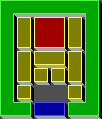One of our daughters obtained a nice sliding puzzle app on her ipad, and it features various levels, each level with several hundreds of puzzles.
The app is also available on android as “unblock me”, by Kiragames. It is also available in Googles play store for windows, see https://play.google.com/store/apps/details?id=com.kiragames.unblockmefree&hl=en.
I tried the app and the puzzles start out easy, but soon turn out to present decent challenges. Reason enough for a post on this type of puzzles. I’ll limit myself in this post to 2d sliding block puzzles. There are many 3d sliding block puzzles too: puzzle collectors may remember the many secret boxes puzzles, often beautifully crafted by woodworkers. But those are worth a different post.
There are many types of sliding block puzzles. Sam Loyds 15 puzzle is probably the most famous one. Many sliding block puzzles have been computerized, and the Sokoban puzzles are perhaps the first type of sliding block puzzle that exists only as a computer puzzle and not as a mechanical puzzle. But in this post I’d like to take a closer look at the type of sliding block puzzle that at the English wikipedia is called Klotski. I feel some doubt at this name: it may be derived from polish, as the article says, but when I view the history of the article I think it is more likely that Klotski is the name of a computer or video game instead of the name of this type of puzzle. I have never encountered the name Klotski for this type of puzzle in any puzzle book.

Sliding Piece Puzzles (by Edward Hordern, 1986, Oxford University Press, ISBN 0-19-853204-0) is said to be the definitive volume on this type of puzzle. It lists 270 of his sliding block puzzles, all neatly categorized and with the solution in the shortest number of moves. That brings us of course to the question: what is a move?
Hordern lists 4 possibilities:
a) a sliding block is moved as many ‘units’ in one or more directions
b) a sliding block is moved one ‘unit’ in 1 direction
c) a group of sliding blocks is moved one or more units in 1 direction.
d) a sliding block is moved one or more units in one direction.
Option a) is most common among puzzlers, mainly because it corresponds with a physical action: move a block as far as you want without lifting your finger from the piece.
Horderns also subdivides sliding block puzzles in four categories:
I. Sliding block pieces – pieces move independent of each other.
II. Warehouse/soko puzzles: one piece pushes others.
III. Railway shunting puzzles – one or two pieces push or pull all the others
IV. Puzzles with plungers or levers.
I already treated railway shunting puzzles, and category IV is a group of rather rare and complicated puzzles. This post deals entirely with group I, and with the subgroup where pieces are rectangular and of unequal size.
The nice thing about mechanical puzzles is that you can patent them, such as USA patent 207,124.
I’m not sure about the early history of sliding block puzzles. Sam Loyds puzzles goes back to the 1870’s. One Henry Walton filed U.S. Patent 516,035 on 1893-03-14 for a sliding puzzle resembling 15-puzzle. According to Edward Hordern, this is the first even known sliding puzzle with rectangular blocks.
Horderns book “sliding block puzzles”, mentioned above, is the standard work of reference for this type of puzzle.
Links:
* http://www.novelgames.com/gametips/?id=121: Only 3 levels, but nrs 2 and 3 are a nice challenge
* http://www.spel.nl/game/sliding-block-puzzle.html – several classics
* http://www.cleverwood.com/about_sliding_block_puzzles.htm – general information and some links
* http://www.johnrausch.com/slidingblockpuzzles/
* http://home.comcast.net/~stegmann/sliding.htm – robs puzle page, examples of sliding block puzzles
